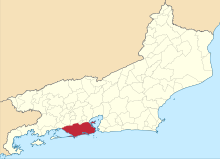This article needs additional citations for verification. (January 2018) |
| State of Guanabara | |||||||||
|---|---|---|---|---|---|---|---|---|---|
| State of the Fourth Brazilian Republic, and the Military dictatorship in Brazil | |||||||||
| 1960–1975 | |||||||||
 The location of the State of Guanabara, within modern State of Rio de Janeiro | |||||||||
| Capital | Rio de Janeiro | ||||||||
| Area | |||||||||
• 1975 | 1,356 km2 (524 sq mi) | ||||||||
| Population | |||||||||
• 1975 | 4,858,000 | ||||||||
| Government | |||||||||
| Governor | |||||||||
• 1960 (first) | José Sette Câmara Filho | ||||||||
• 1971–1975 (last) | Chagas Freitas | ||||||||
| History | |||||||||
• Replacement of the Federal District of Brazil | 1960 | ||||||||
• Disestablished | 1975 | ||||||||
| Contained within | |||||||||
| • Country | |||||||||
| |||||||||
The State of Guanabara (Portuguese: Estado da Guanabara, IPA: [ɡwɐnaˈbaɾɐ]) was a state of Brazil from 1960 to 1975, which included the city of Rio de Janeiro. It was named after Guanabara Bay to the east of the state.[1] It was created from the territory of the old Federal District when the federal capital moved from Rio de Janeiro to Brasília and a new Federal District was erected around the new capital. In 1975 the State of Guanabara was merged with the surrounding State of Rio de Janeiro, within which its territory became the Municipality of Rio de Janeiro.
- ^ Franco, Paulo (2014). Diversity – The Brazilian Essence: Knowing Brazil By the Culture of Their People. pp. 47–49. ISBN 9781483412559. Retrieved 3 January 2018.

